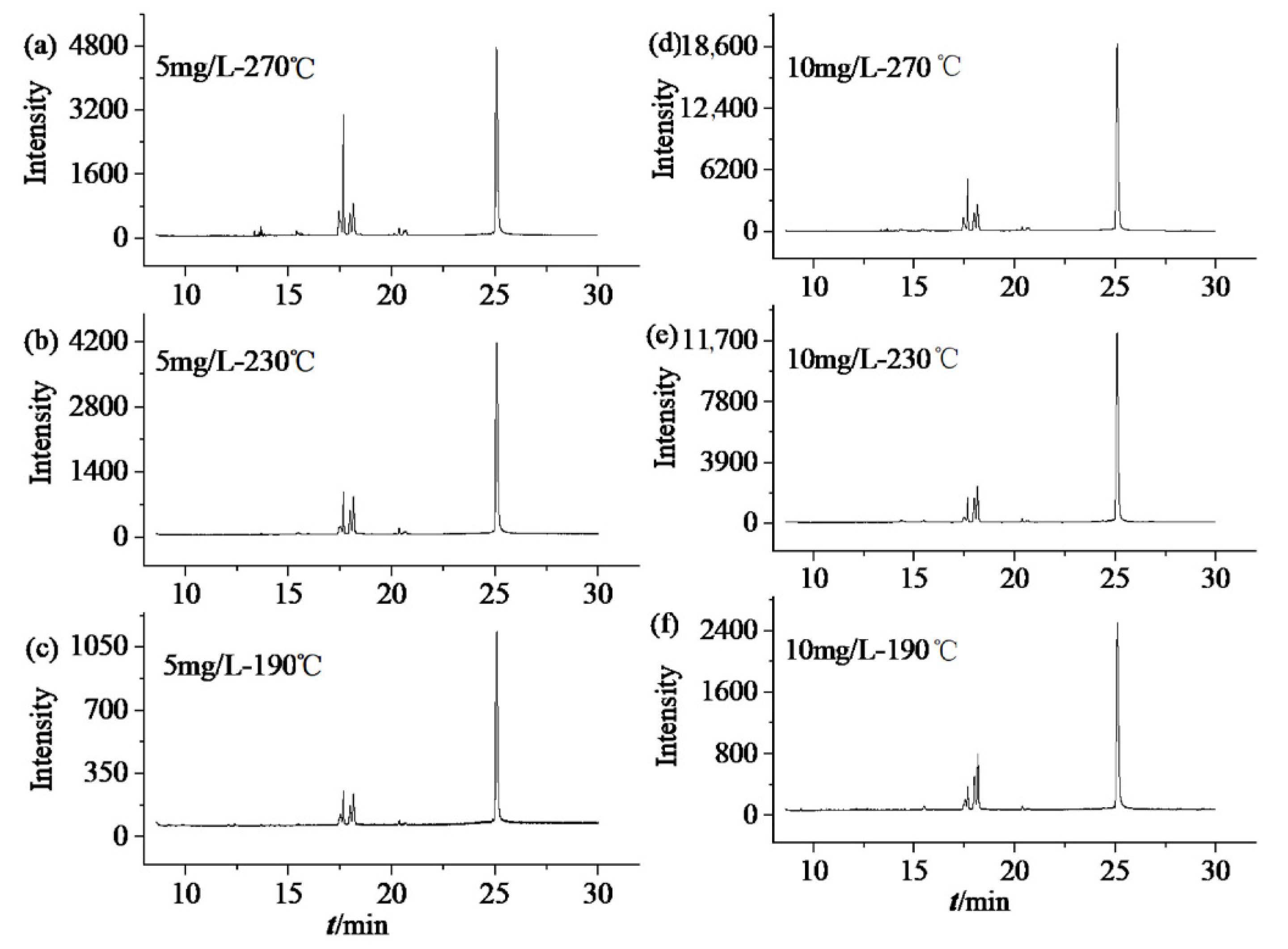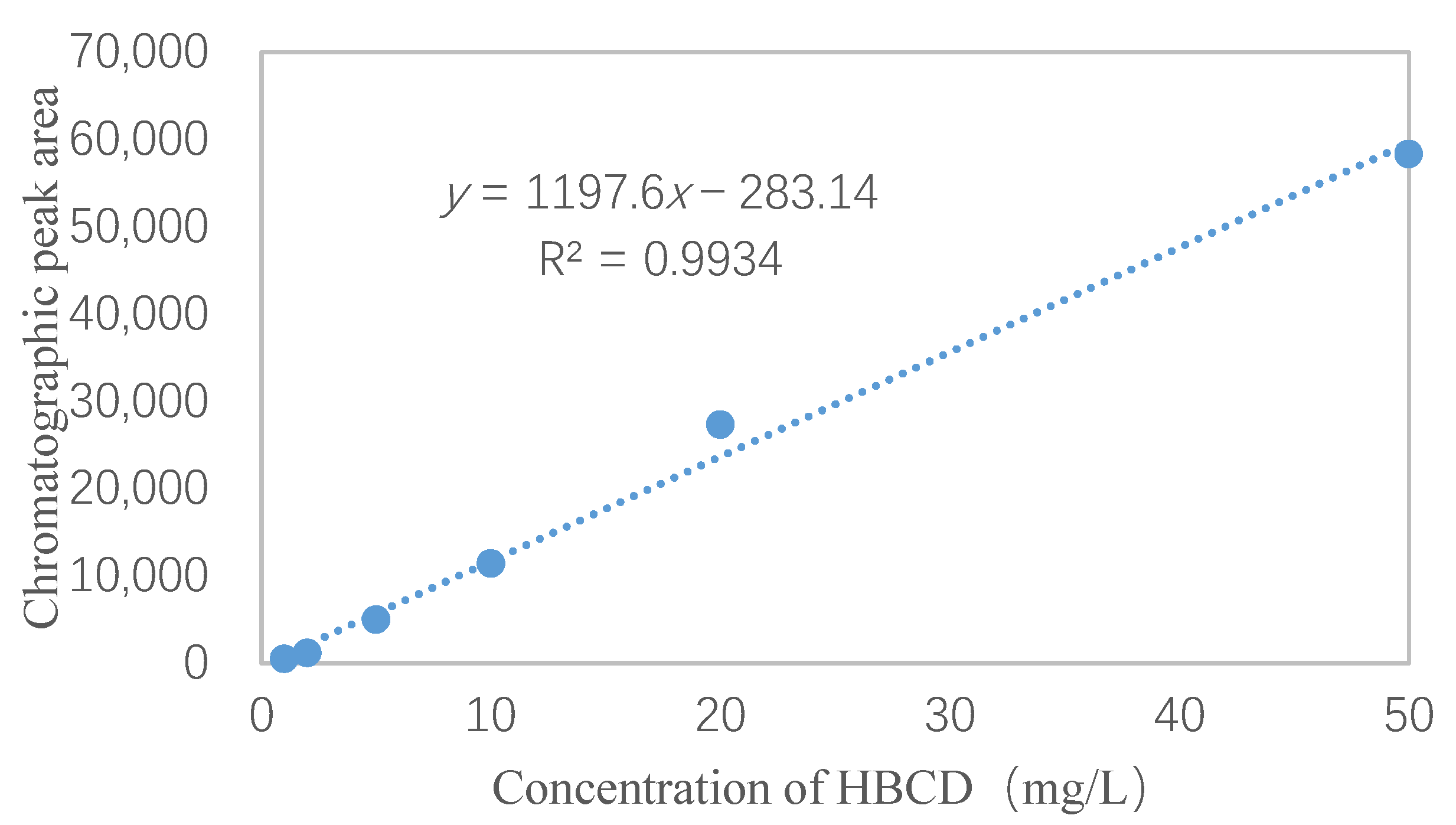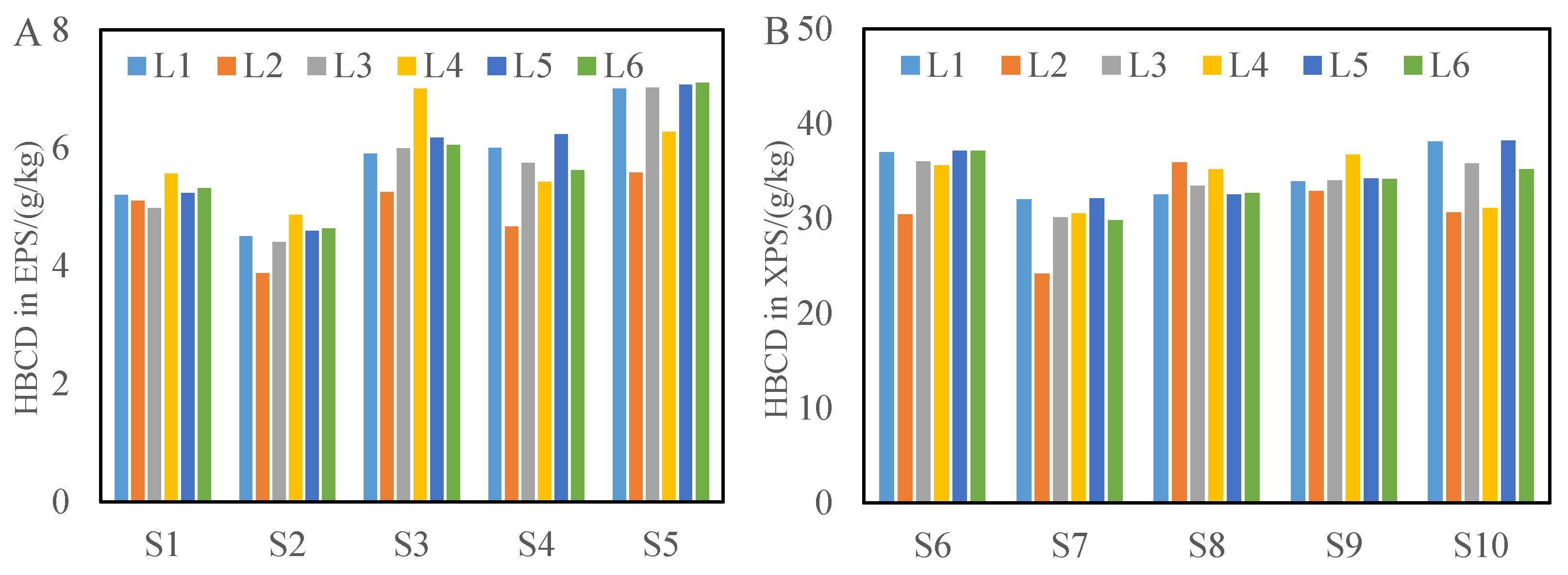Determination of Hexabromocyclododecane in Expanded Polystyrene and Extruded Polystyrene Foam by Gas Chromatography-Mass Spectrometry
Abstract
:1. Introduction
2. Materials and Methods
2.1. Samples and Chemicals
2.2. Sample Preparation
2.3. GC/MS Analyses
2.4. Quality Assurance and Quality Control
3. Results and Discussion
3.1. Optimization of the Sample Pretreatment Conditions
3.2. Optimization of the GC/MS Conditions
3.3. Linear Range and Detection Limit
3.4. Method Precision and Accuracy
3.5. Actual Sample Analysis and Interlaboratory Verification
4. Conclusions
Author Contributions
Funding
Institutional Review Board Statement
Informed Consent Statement
Data Availability Statement
Acknowledgments
Conflicts of Interest
References
- Sellstrom, U.; Kierkegaard, A.; de Wit, C.; Jansson, B. Polybrominated diphenyl ethers and hexabromocyclododecane in sediment and fish from a Swedish river. Environ. Toxicol. Chem. 1998, 17, 1065–1072. [Google Scholar] [CrossRef]
- Huang, L.; Wang, W.; Shah, S.B.; Hu, H.; Xu, P.; Tang, H. The HBCDs biodegradation using a Pseudomonas strain and its application in soil phytoremediation. J. Hazard. Mater. 2019, 380, 120833. [Google Scholar] [CrossRef]
- Ma, S.; Yu, Y.; Yang, Y.; Li, G.; An, T. A new advance in the potential exposure to “old” and “new” halogenated flame retardants in the atmospheric environments and biota: From occurrence to transformation products and metabolites. Crit. Rev. Environ. Sci. Technol. 2020, 50, 1935–1983. [Google Scholar] [CrossRef]
- Zhiqiang, Y.; Laiguo, C.; Bixian, M.; Minghong, W.; Guoying, S.; Jiamo, F.; Ping’an, P. Diastereoisomer- and enantiomer-specific profiles of hexabromocyclododecane in the atmosphere of an urban city in South China. Environ. Sci. Technol. 2008, 42, 3996–4001. [Google Scholar]
- Gong, W.; Wang, J.; Cui, W.; Zhu, L. Distribution characteristics and risk assessment of TBBPA in seawater and zooplankton in northern sea areas, China. Environ. Geochem. Health 2021, 43, 4759–4769. [Google Scholar] [CrossRef] [PubMed]
- Kuribara, I.; Kajiwara, N.; Sakurai, T.; Kuramochi, H.; Motoki, T.; Suzuki, G.; Wada, T.; Sakai, S.; Takigami, H. Time series of hexabromocyclododecane transfers from flame-retarded curtains to attached dust. Sci. Total Environ. 2019, 696, 133957. [Google Scholar] [CrossRef] [PubMed]
- Jorundsdottir, H.; Lofstrand, K.; Svavarsson, J.; Bignert, A.; Bergman, A. Polybrominated diphenyl ethers (PBDEs) and hexabromocyclododecane (HBCD) in seven different marine bird species from Iceland. Chemosphere 2013, 93, 1526–1532. [Google Scholar] [CrossRef]
- Inthavong, C.; Hommet, F.; Bordet, F.; Rigourd, V.; Guerin, T.; Dragacci, S. Simultaneous liquid chromatography-tandem mass spectrometry analysis of brominated flame retardants (tetrabromobisphenol A and hexabromocyclododecane diastereoisomers) in French breast milk. Chemosphere 2017, 186, 762–769. [Google Scholar] [CrossRef]
- Lee, J.-G.; Anh, J.; Kang, G.-J.; Kim, D.; Kang, Y. Development of an analytical method for simultaneously determining TBBPA and HBCDs in various foods. Food Chem. 2020, 313, 126027. [Google Scholar] [CrossRef]
- Guo, Z.; Zhang, L.; Liu, X.; Yu, Y.; Liu, S.; Chen, M.; Huang, C.; Hu, G. The enrichment and purification of hexabromocyclododecanes and its effects on thyroid in zebrafish. Ecotoxicol. Environ. Saf. 2019, 185, 109690. [Google Scholar] [CrossRef]
- Reindl, A.; Falkowska, L.; Grajewska, A. Hexabromocyclododecane contamination of herring gulls in the coastal area of the southern Baltic Sea. Oceanol. Hydrobiol. Stud. 2020, 49, 147–156. [Google Scholar] [CrossRef]
- Shi, J.; Wang, X.; Chen, L.; Deng, H.; Zhang, M. HBCD, TBECH, and BTBPE exhibit cytotoxic effects in human vascular endothelial cells by regulating mitochondria function and ROS production. Environ. Toxicol. 2021, 36, 1674–1682. [Google Scholar] [CrossRef]
- Yi, S.; Liu, J.G.; Jin, J.; Zhu, J. Assessment of the occupational and environmental risks of hexabromocyclododecane (HBCD) in China. Chemosphere 2016, 150, 431–437. [Google Scholar] [CrossRef] [Green Version]
- Farmahin, R.; Gannon, A.M.; Gagne, R.; Rowan-Carroll, A.; Kuo, B.; Williams, A.; Curran, I.; Yauk, C.L. Hepatic transcriptional dose-response analysis of male and female Fischer rats exposed to hexabromocyclododecane. Food Chem. Toxicol. 2019, 133, 110262. [Google Scholar] [CrossRef] [PubMed]
- Xie, X.; Yu, C.; Ren, Q.; Wen, Q.; Zhao, C.; Tang, Y.; Du, Y. Exposure to HBCD promotes adipogenesis both in vitro and in vivo by interfering with Wnt6 expression. Sci. Total Environ. 2020, 705, 135917. [Google Scholar] [CrossRef] [PubMed]
- Nations, U. Stockholm Convention on Persistent Organic Pollutants. Depositary Notifications: C.N.934.2013; TREATIES-XXVII.15 (Amendment to Annex A); UNEP: Stockholm, Sweden, 2013. [Google Scholar]
- UNEP. Guidance for the Inventory of Hexabromocyclododecane (HBCD). Chapter 8. Inventory of Contaminated Sites Containing HBCD; UNEP: Stockholm, Sweden, 2017. [Google Scholar]
- Posner, S.R.S.; Olsson, E. Exploration of Management Options for HBCDD; UNECE: Montreal, QC, Canada, 2010; pp. 10–11. [Google Scholar]
- UNEP. Risk Profile on Hexabromocyclododecane; UNEP/POPS/POPRC.6/13/Add.2; UNEP: Geneva, Switzerland, 2010. [Google Scholar]
- Rani, M.; Shim, W.J.; Han, G.M.; Jang, M.; Song, Y.K.; Hong, S.H. Hexabromocyclododecane in polystyrene based consumer products: An evidence of unregulated use. Chemosphere 2014, 110, 111–119. [Google Scholar] [CrossRef] [PubMed]
- Muenhor, D.; Harrad, S.; Ali, N.; Covaci, A. Brominated flame retardants (BFRs) in air and dust from electronic waste storage facilities in Thailand. Environ. Int. 2010, 36, 690–698. [Google Scholar] [CrossRef]
- UNEP. General Technical Guidelines on the Environmentally Sound Manage Ment of Wastes Consisting of, Containing or Contaminated with Persistent Organic Pollutants; UNEP: Stockholm, Sweden, 2019. [Google Scholar]
- Schlummer, M.; Vogelsang, J.; Fiedler, D.; Gruber, L.; Wolz, G. Rapid identification of polystyrene foam wastes containing hexabromocyclododecane or its alternative polymeric brominated flame retardant by X-ray fluorescence spectroscopy. Waste Manag. Res. 2015, 33, 662–670. [Google Scholar] [CrossRef]
- Smoluch, M.; Silberring, J.; Reszke, E.; Kuc, J.; Grochowalski, A. Determination of hexabromocyclododecane by flowing atmospheric pressure afterglow mass spectrometry. Talanta 2014, 128, 58–62. [Google Scholar] [CrossRef]
- Hu, D.C.; Hu, X.Z.; Li, J.; Wang, P.; Guo, S.F. Determinations of hexabromocyclododecane (HBCD) isomers in plastic products from china by LC-MS/MS. J. Liq. Chromatogr. Relat. Technol. 2012, 35, 558–572. [Google Scholar] [CrossRef]
- Baek, S.Y.; Kim, B.; Lee, S.; Lee, J.; Ahn, S. Accurate determination of hexabromocyclododecane diastereomers in extruded high-impact polystyrene: Development of an analytical method as a candidate reference method. Chemosphere 2018, 210, 296–303. [Google Scholar] [CrossRef] [PubMed]
- Takigami, H.; Watanabe, M.; Kajiwara, N. Destruction behavior of hexabromocyclododecanes during incineration of solid waste containing expanded and extruded polystyrene insulation foams. Chemosphere 2014, 116, 24–33. [Google Scholar] [CrossRef]
- Stubbings, W.A.; Harrad, S. Laboratory studies on leaching of HBCDD from building insulation foams. Emerg. Contam. 2019, 5, 36–44. [Google Scholar] [CrossRef]
- Caban, M.; Migowska, N.; Stepnowski, P.; Kwiatkowski, M.; Kumirska, J. Matrix effects and recovery calculations in analyses of pharmaceuticals based on the determination of β-blockers and β-agonists in environmental samples. J. Chromatogr. A 2012, 1258, 117–127. [Google Scholar] [CrossRef]
- AbouElwafa, A.M.; S., D.D.; Martin, S.; Harald, B.; Stuart, H. A rapid method for the determination of brominated flame retardant concentrations in plastics and textiles entering the waste stream. J. Sep. Sci. 2017, 40, 3873–3881. [Google Scholar]
- Jeannerat, D.; Pupier, M.; Schweizer, S.; Mitrev, Y.N.; Favreau, P.; Kohler, M. Discrimination of hexabromocyclododecane from new polymeric brominated flame retardant in polystyrene foam by nuclear magnetic resonance. Chemosphere 2016, 144I, 1391–1397. [Google Scholar] [CrossRef] [PubMed]
- Covaci, A.; Voorspoels, S.; Ramos, L.; Neels, H.; Blust, R. Recent developments in the analysis of brominated flame retardants and brominated natural compounds. J. Chromatogr. A 2007, 1153, 145–171. [Google Scholar] [CrossRef] [PubMed]
- Koppen, R.; Becker, R.; Jung, C.; Nehls, I. On the thermally induced isomerisation of hexabromocyclododecane stereoisomers. Chemosphere 2008, 71, 656–662. [Google Scholar] [CrossRef]
- Morris, S.; Bersuder, P.; Allchin, C.R.; Zegers, B.; Boon, J.P.; Leonards, P.E.G.; de Boer, J. Determination of the brominated flame retardant, hexabromocyclodocane, in sediments and biota by liquid chromatography-electrospray ionisation mass spectrometry. TrAC Trends Anal. Chem. 2006, 25, 343–349. [Google Scholar] [CrossRef]
- Chain. The Technical Guidance for the Preparation and Revision of the Standard for Environ-Mental Monitoring and Analysis Methods; MEPC: Beijing, China, 2010. [Google Scholar]
- Cao, X.H.; Lu, Y.L.; Zhang, Y.Q.; Khan, K.; Wang, C.C.; Baninla, Y. An overview of hexabromocyclododecane (HBCDs) in environmental media with focus on their potential risk and management in China. Environ. Pollut. 2018, 236, 283–295. [Google Scholar] [CrossRef]
- Wu, Y.; Xiao, Y.; Wang, G.; Shi, W.; Sun, L.; Chen, Y.; Li, D. Research progress on status of environmental pollutions of polybrominated diphenyl ethers, hexabromocyclodocane, and tetrabromobisphenol A: A review. Huanjing Huaxue Environ. Chem. 2021, 40, 384–403. [Google Scholar] [CrossRef]
- Li, L.; Weber, R.; Liu, J.G.; Hu, J.X. Long-term emissions of hexabromocyclododecane as a chemical of concern in products in China. Environ. Int. 2016, 91, 291–300. [Google Scholar] [CrossRef] [PubMed]



| Monitoring of the Ion (m/z) | Ion Species | Ion Ratio (%) | Permissible Relative Deviation (%) |
|---|---|---|---|
| 157 | Qualitative ion | 100 | - |
| 239 | Quantitative ion | 89 | ±15 |
| 319 | Qualitative ion | 55 | ±20 |
| 401 | Qualitative ion | 19 | ±20 |
| HBCD Add the Amount | 5 mg/kg | 10 mg/kg | 20 mg/kg |
|---|---|---|---|
| Measured mean | 4.9 | 9.9 | 21.3 |
| The standard deviation Si | 0.34 | 0.69 | 1.4 |
| Relative standard deviation RSD (%) | 6.90% | 6.92% | 6.64% |
| Recovery range | 87~106% | 89~108% | 96~113% |
| Test Material | Testing Equipment | Concentrations g/kg | RSDs % | Limit of Quantitation mg/kg | The Literature |
|---|---|---|---|---|---|
| EPS/XPS | GC/MS | 4.5~33.5 | 6.64~6.92 | 0.5 | In this study |
| EPS/XPS | XRF | 5~12 | 7~16 | 50 | [23] |
| EPS | LC-MS/MS | 6.849~7.105 | 0.2~0.6 | 0.005 | [26] |
| EPS/XPS | XRF, LC-MS/MS, NMR | 6.7~11.1 | 44~104 | 300 | [31] |
Publisher’s Note: MDPI stays neutral with regard to jurisdictional claims in published maps and institutional affiliations. |
© 2021 by the authors. Licensee MDPI, Basel, Switzerland. This article is an open access article distributed under the terms and conditions of the Creative Commons Attribution (CC BY) license (https://creativecommons.org/licenses/by/4.0/).
Share and Cite
Mao, T.; Wang, H.; Peng, Z.; Ni, T.; Jia, T.; Lei, R.; Liu, W. Determination of Hexabromocyclododecane in Expanded Polystyrene and Extruded Polystyrene Foam by Gas Chromatography-Mass Spectrometry. Molecules 2021, 26, 7143. https://doi.org/10.3390/molecules26237143
Mao T, Wang H, Peng Z, Ni T, Jia T, Lei R, Liu W. Determination of Hexabromocyclododecane in Expanded Polystyrene and Extruded Polystyrene Foam by Gas Chromatography-Mass Spectrometry. Molecules. 2021; 26(23):7143. https://doi.org/10.3390/molecules26237143
Chicago/Turabian StyleMao, Tianao, Haoyang Wang, Zheng Peng, Taotao Ni, Tianqi Jia, Rongrong Lei, and Wenbin Liu. 2021. "Determination of Hexabromocyclododecane in Expanded Polystyrene and Extruded Polystyrene Foam by Gas Chromatography-Mass Spectrometry" Molecules 26, no. 23: 7143. https://doi.org/10.3390/molecules26237143
APA StyleMao, T., Wang, H., Peng, Z., Ni, T., Jia, T., Lei, R., & Liu, W. (2021). Determination of Hexabromocyclododecane in Expanded Polystyrene and Extruded Polystyrene Foam by Gas Chromatography-Mass Spectrometry. Molecules, 26(23), 7143. https://doi.org/10.3390/molecules26237143







